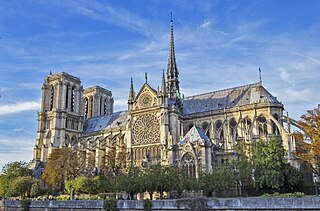
Notre-Dame de Paris, referred to simply as Notre-Dame, is a medieval Catholic cathedral on the Île de la Cité, in the 4th arrondissement of Paris, France. The cathedral, dedicated to the Virgin Mary, is considered one of the finest examples of French Gothic architecture. Several attributes set it apart from the earlier Romanesque style, particularly its pioneering use of the rib vault and flying buttress, its enormous and colourful rose windows, and the naturalism and abundance of its sculptural decoration. Notre-Dame also stands out for its three pipe organs and its immense church bells.

Auxerre Cathedral is a Roman Catholic church, dedicated to Saint Stephen, located in Auxerre, Burgundy, France. It was constructed between the 13th and 16th centuries, on the site of a Romanesque cathedral from the 11th century, whose crypt is found underneath the cathedral. It is known for 11th century Carolingian frescoes found in the crypt, and for its large stained glass windows. Since 1823 it has been the seat of a diocese united with that of Sens Cathedral.
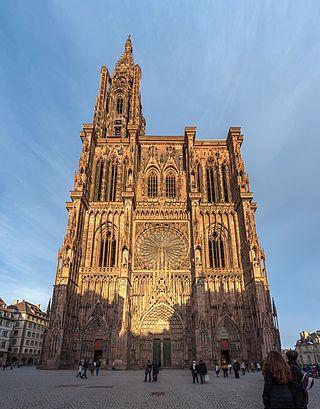
Strasbourg Cathedral or the Cathedral of Our Lady of Strasbourg, also known as Strasbourg Minster, is a Catholic cathedral in Strasbourg, Alsace, France. Although considerable parts of it are still in Romanesque architecture, it is widely considered to be among the finest examples of Rayonnant Gothic architecture. Architect Erwin von Steinbach is credited for major contributions from 1277 to his death in 1318, and beyond through his son Johannes von Steinbach, and his grandson Gerlach von Steinbach, who succeeded him as chief architects. The Steinbachs’ plans for the completion of the cathedral were not followed through by the chief architects who took over after them, and instead of the originally envisioned two spires, a single, octagonal tower with an elongated, octagonal crowning was built on the northern side of the west facade by master Ulrich Ensingen and his successor, Johannes Hültz. The construction of the cathedral, which had started in the year 1015 and had been relaunched in 1190, was finished in 1439.

Rouen Cathedral is a Catholic church in Rouen, Normandy, France. It is the see of the Archbishop of Rouen, Primate of Normandy. It is famous for its three towers, each in a different style. The cathedral, built and rebuilt over a period of more than eight hundred years, has features from Early Gothic to late Flamboyant and Renaissance architecture. It also has a place in art history as the subject of a series of impressionist paintings by Claude Monet.

Flamboyant is a form of late Gothic architecture that developed in Europe in the Late Middle Ages and Renaissance, from around 1375 to the mid-16th century. In the French timetable of styles, as defined by French scholars, it is the fourth phase of Gothic style, preceded by Primary Gothic, Classic Gothic and Rayonnant Gothic.
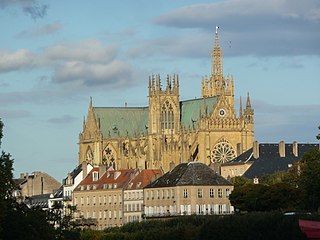
Metz Cathedral, is the cathedral of the Catholic Diocese of Metz, the seat of the bishops of Metz. It is dedicated to Saint Stephen. The diocese dates back at least to the 4th century and the present cathedral building was begun in the early 14th century. In the mid-14th century, it was joined to the collegiate church of Notre-Dame, and given a new transept and late Gothic chevet, finished between 1486 and 1520. The cathedral treasury displays a rich collection assembled over the long centuries of the history of the Metz diocese and include sacred vestments and items used for the Eucharist.

Soissons Cathedral is a Gothic basilica church in Soissons, France. It is the seat of the Bishop of Soissons, Laon, and Saint-Quentin. The construction of the south transept was begun about 1177, and the lowest courses of the choir in 1182.

Rodez Cathedral is a Roman Catholic church located in town of Rodez, in the department of Aveyron in the Occitanie region of Southern France. The cathedral is a national monument and is the seat of the Bishopric of Rodez. The west front, of a military appearance and without a portal, formerly was part of the city wall of Rodez. Notable elements include a Flamboyant Gothic and Renaissance tower, and a Renaissance rood screen and choir stalls.

Saint-Brieuc Cathedral is a Roman Catholic church located in the town of Saint-Brieuc, Brittany, France, and dedicated to Saint Stephen.

French Gothic architecture is an architectural style which emerged in France in 1140, and was dominant until the mid-16th century. The most notable examples are the great Gothic cathedrals of France, including Notre-Dame Cathedral, Reims Cathedral, Chartres Cathedral, and Amiens Cathedral. Its main characteristics are verticality, or height, and the innovative use of the rib vault and flying buttresses and other architectural innovations to distribute the weight of the stone structures to supports on the outside, allowing unprecedented height and volume. The new techniques also permitted the addition of larger windows, including enormous stained glass windows, which fill the cathedrals with light.

Tréguier Cathedral is a Roman Catholic church and former cathedral in Tréguier, Côtes-d'Armor, France. It is dedicated to Saint Tudwal. The church was formerly the seat of the Bishopric of Tréguier, abolished under the Concordat of 1801, when its territories were divided between the Diocese of Quimper and the Diocese of Saint-Brieuc, known since 1852 as Saint-Brieuc-Tréguier.

Senlis Cathedral is a Roman Catholic church and former cathedral in Senlis, Oise, France.

Toul Cathedral is a Roman Catholic church in Toul, Lorraine, France. It is a classic example of late Gothic architecture in the Flamboyant style. The cathedral has one of the biggest cloisters in France.
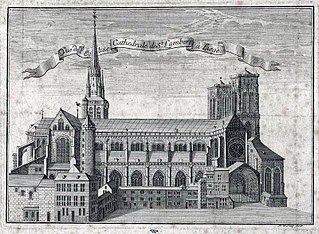
St. Lambert's Cathedral was the cathedral of Liège, Belgium, until 1794, when its destruction began. This enormous Gothic cathedral, dedicated to Saint Lambert of Maastricht, occupied the site of the present Place Saint-Lambert in the centre of Liège.

Notre-Dame de Reims, known in English as Reims Cathedral, is a Roman Catholic cathedral in the French city of the same name, the archiepiscopal see of the Archdiocese of Reims. The cathedral was dedicated to the Virgin Mary and was the traditional location for the coronation of the kings of France. Reims Cathedral is considered to be one of the most important pieces of Gothic architecture. The cathedral, a major tourist destination, receives about one million visitors annually. It became a UNESCO World Heritage Site in 1991.
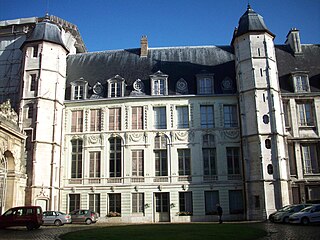
The Archiepiscopal Palace of Rouen is the official residence of the Metropolitan Archbishop of Rouen, Primate of Normandy. Designated a Monument Historique for the first time in 1862, it is notably the only archiepiscopal palace in France that is adjoining a cathedral while retaining its original function as official residence of the archbishop.
Jenson Salvart (1398–1447) was a 15th-century French master builder.
Colin Biart, also called Colin Biard, Nicolas Biart or Colin Byart or Nicolas Byart, was a French master mason, master builder, and architect, born in Amboise in 1460, active until 1515.
Antoine Salvanh, was a Rouergat architect from the first half of the 16th century who made the transition between the flamboyant gothic and the First Renaissance styles.

The spire of Notre-Dame de Paris is located above the cross-section of the cathedral's transept. Notre-Dame de Paris has had three timber spires, known as flèches. The first was built between 1220 and 1230. It eventually became so damaged that it was removed in the late 18th century. The second was put into place by the French architect Eugène Viollet-le-Duc in 1859, and destroyed in a major fire on 15 April 2019. Work to construct a third one started in 2022, and was completed when the new copper rooster wind vane was placed on top of the new spire on 16 December 2023.




















